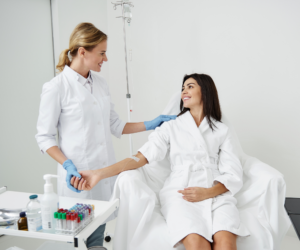
Drug overdose deaths in the United States topped 100,000 between 2020 and 2021. During this 12-month stint, overdoses skyrocketed by 28.5% compared to prior years.
COVID-19 lockdowns and social isolation made it challenging for individuals to find the help they needed. If you or a loved one are willing to take that next step along the recovery road, you may have heard of NAD infusions.
NAD infusions work differently than other treatment options. It uses your body’s natural chemicals and promotes long-term healing.
Luckily, we have put together a complete guide on what NAD infusions are and how they work seamlessly in your recovery process. Keep reading on and find out more!
What Are Addictions?
Addictions are primarily classified into two categories:
- Substances
- Behaviors
Substance use disorders include abusing drugs or alcohol to the point it begins causing mental, emotional, or physical harm to yourself and others. It is a chronic medical condition that often reroutes neuropathways and leads to compulsive behaviors.
If left untreated, addictions can lead to overdoses or self-harm. An important distinction is the term misuse and addiction.
Some people misuse their prescription medications one time because they are in a lot of pain. Others may drink heavily for one night, resulting in poor health consequences.
Addiction stems beyond that and is a recurrent behavior and pattern. For this article, let’s dive into substance use disorders.
Substance Use Disorders 101
Substances include alcohol and drugs, which aren’t limited to illicit medications. Many drugs that lead to addictions can be from prescriptions, such as pain killers, anxiety medications, or sleeping pills.
Two of the more common substances that lead to addiction are opioids and alcohol. They are otherwise known as opioid use disorder and alcohol use disorder.
Opioid Use Disorder
Opioids are a classification of drugs often used for pain management, including:
- Morphine
- Heroin
- Fentanyl
- Oxycodone
- Hydrocodone
- Methadone
Between 2019 and 2020, opioid overdoses increased by 30%, with fentanyl creating additional risk with its high potency. Some of the signs of an opioid use disorder are:
- Inability to control the use of opioids
- Drug cravings
- Irritability
- Weight loss
- Withdrawal symptoms
Withdrawal symptoms occur when a person becomes physically dependent on the drug before stopping use. Some of these symptoms might entail anxiety, nausea, diarrhea, rapid heart rate, and high blood pressure.
Most opioid withdrawal symptoms dissipate after 72 hours and aren’t life-threatening like alcohol withdrawals can be. Although, it does pose a risk of relapse. A detox center is the best place for a person to withdraw from drugs safely.
Alcohol Use Disorder
Alcohol use disorder has similar signs of addiction, such as changes in mood, behaviors, or cravings. However, while opioids are pain relievers, alcohol is a central nervous system depressant.
This fundamental distinction makes alcohol withdrawals more dangerous in ways. When you become accustomed to higher amounts of alcohol, your central nervous system has to compensate. Suddenly removing alcohol will kick your central nervous into an “overdrive.”
Once this happens, you will start to notice these symptoms:
- Tremors
- Sweating
- Nausea
- Vomiting
- Hypertension
- Tachycardia
Between 12 to 24 hours after stopping alcohol intake, you could start developing hallucinations and seizures. These are medical emergencies that require an alcohol rehab and detox center.
If left untreated, severe alcohol withdrawal results in delirium tremens. Delirium tremens is fatal in 37% of cases, usually leading to cardiac arrest.
Are Rehab Centers Helpful?

Rehab centers is a broad term that includes multiple levels of care. The most medically intensive portion of rehab is the detox center. Patients are in acute stages of withdrawal and may require medication-assisted treatment or close vital monitoring.
Alcohol use disorders have the potential to create a thiamine deficiency. Without B vitamin and thiamin infusions, thiamine deficiencies can cause permanent neurological deficits or mortality. Detox centers and medical professionals can evaluate blood work and determine the best course of action.
However, rehab isn’t all doom and gloom. It is also very helpful for individuals with mild addictions who need extra moral support and therapy. Beyond detox centers, there are other types of rehabilitation, such as:
- Residential treatment
- Partial hospitalization programs
- Outpatient therapy
- Intensive outpatient therapy
Some patients may need all stages of recovery, while others might go straight into outpatient therapy. Rehab centers are instrumental since they focus on evidence-based research to help you or a loved one achieve long-term sobriety goals. Research shows that approximately 75% of people with addictions recover, and a big part of their success is from seeking therapy and rehab.
Substance Use Disorder Treatments
Addictions and substance use disorders are well-managed with multiple treatments and therapies. Some of the most popular ones include:
- Cognitive-behavioral therapy (CBT)
- Dialectical behavioral therapy (DBT)
- Group therapy
- Medication-assisted treatment
- And more
Recent evidence suggests that nicotinamide adenine dinucleotide (NAD) may hold the answers.
What Is NAD?
At its core, NAD is a chemical. You can find it throughout the body, and it assists in cellular metabolism. During these reactions, NAD transports electrons between different cells, creating a chemical or cellular reaction.
You may also hear it called NAD+. This is its primary form once vitamin B3 comes into contact with adenine. NAD+ also plays a critical role in creating ATP, which helps store and release energy.
And ultimately, that is the goal of NAD – energy production. But NAD has a host of other benefits as researchers dive into this essential chemical, such as:
- Communication
- Autonomic nervous system function
- Maintaining equilibrium
- Prevent neurodegeneration
- Regulate circadian rhythm
- Manage inflammation
- Boost immune system health
When NAD levels drop, your body is no longer in homeostasis. This places you at a greater risk for diseases, illnesses, and other disorders. When NAD levels increase, DNA begins repairing, and immune health improves.
Ultimately, adequate NAD levels show better cellular metabolism and life, increasing human lifespan.
Symptoms of NAD Deficiencies
NAD levels naturally begin decreasing with age. This process leads to numerous age-related diseases and illnesses, including plasticity. The term “plasticity” is well-known amongst neurologists who use neuroplasticity to determine how a person can heal or recover after injury.
Ultimately, lower NAD levels put you more at risk for:
- Cancer
- Heart disease
- Diabetes
- Dementia
- Neurodegenerative diseases
What are the initial signs this chemical is hovering low? If you remember, NAD is a catalyst for energy, and one of the critical signs is lower energy levels. You may experience other low NAD symptoms such as:
- Brain fog
- Muscle weakness
- Diarrhea
- Inflammation
- Skin sores
- Abdominal pain
- Cognitive changes (e.g., difficulty thinking)
Chronically low levels of vitamin B3 also lead to a condition called pellagra, which can cause long-term health complications.
NAD Infusions and Addiction
Drugs and alcohol are other common causes of low NAD levels. Combined with poor dieting or aging, this problem can escalate quickly.
NAD IV therapy helps restore these levels and allows the brain to start healing. How does this entire process work?
It starts with changes in neuropathways and neurotransmitters. As your brain and nervous system become used to the effects of drugs or alcohol, it adapts to these new stimuli or depressant levels. Over time, neurotransmitters begin desensitizing, essentially making them duller to artificial or natural stimulants.
This process is largely what leads to increased substance use. When the process suddenly stops, your nervous system is still recovering, leading to feelings of brain fog, depression, or sleep impairments.
NAD infusions naturally help the brain heal and repair itself from chronic substance use. NAD typically comes in four different infusions, with NAD as the base and options for different amino acid combinations.
NAD IV therapy takes around eight hours to complete daily. Most patients will need between five to fifteen days for treatments, depending on the severity and recovery timeline.
Patients will need fewer days if they have completed treatment at a detox center or have not used substances during the past three weeks. NAD IV therapy can be used for patients currently using drugs or alcohol, although infusions may be required for closer to two weeks.
Is IV Therapy Safe?

Not only is IV therapy safe, but it is effective for addiction recovery. Extensive studies show that supplementing NAD helps with:
- DNA repair
- Gene expression
- Immunological functions
The FDA currently allows NAD in supplements and IV therapy, and it is deemed safe for human consumption within guidelines. You must receive NAD IV therapy through a qualified and reputable clinic to avoid risks of infections.
At its core, IV therapy is using an intravenous solution to administer chemicals and substances. Primarily, it is widely used for administering vitamins, minerals, medications, and fluids.
Along with NAD infusions, your provider can run bloodwork and determine if there are other critical vitamins and minerals you may be low on. IV therapy’s benefits include:
- Improved immune health.
- Decrease in depressive or anxiety symptoms
- Improved mental clarity
- Migraine and headache relief
- Reduced number of free radicals
- Improved metabolism
During the addiction recovery process, it can reduce withdrawal symptoms. Remember that nutrient-dense IV infusions are different than NAD infusions. It takes less time than NAD IV therapy, and you will need to talk to your qualified clinician about the benefits of using both during your recovery process.
NAD Infusions vs. Medication-Assisted Treatment
Medication-assisted treatment (MAT) uses prescribed medications to reduce withdrawals and cravings. It is not the same as NAD, which is a naturally produced chemical in your body.
Sometimes, MAT is combined with NAD. It will depend on the severity of withdrawal symptoms, previous relapses, and patient history. The most common medications used for this treatment approach are:
- Methadone
- Buprenorphine
- Naltrexone
- Naloxone
Many of these medications are opioid agonists that bind to similar receptors, blunting the effect of taking opioids while mimicking some of their effects. For example, methadone is a long-acting opioid agonist that won’t deliver the same euphoria one would get from misusing opioids.
Some of these medications are available as prescribed oral tablets, while others require intravenous delivery. MAT primarily helps with severe withdrawals and is widely used during acute detoxes. Studies show that methadone and buprenorphine reduce opioid overdoses by 59% after one year.
NAD works differently, and you may not have to decide between one or the other. However, since NAD’s effects mitigate some withdrawal symptoms, you may need less medication to help.
For milder cases, patients could bypass MAT entirely and use NAD. Another key difference is MAT is mainly used for short-term relief and symptom management. It suppresses cravings and relapses but doesn’t target healing and repair.
NAD infusions are designed explicitly for neurological repair and long-term health and wellness.
Are There Other Treatments Available?
Naturopathic and holistic medicine offers excellent treatment options for addiction recovery. For example, acupuncture is an ancient Chinese traditional medicine that is often combined with other alternative treatments. Acupuncture encompasses several benefits like:
- Managing acute and chronic pain
- Reducing chronic fatigue
- Decreasing blood pressure
- Improving mental clarity
- Immune system health
- Reducing stress
- Managing gastrointestinal disorders
It is also used for addiction recovery. Studies have shown vast benefits in how acupuncture can facilitate long-term recovery and sobriety.
The researchers concluded that acupuncture decreased relapse, drug-seeking behavior, and drug cravings. Interestingly, it also impacts the mesolimbic dopamine system, which plays a critical part in how your brain perceives “rewards.” Acupuncture shows an ability to regulate a hypoactive or hyperactive mesolimbic dopamine system.
Find NAD Infusions Near You
Have you or a loved one been struggling with substance use disorders? Drugs and alcohol can change how the brain responds to neurotransmitters, dulling its receptors over time.
When you start the path to recovery, you may be left with feelings of sluggishness, brain fog, and poor immune health. Now that researchers understand NAD infusions and their role in addiction recovery, options are available for you or a loved one.
Contact us today and get started with a consultation for NAD therapy to see the positive changes it can make for you!
